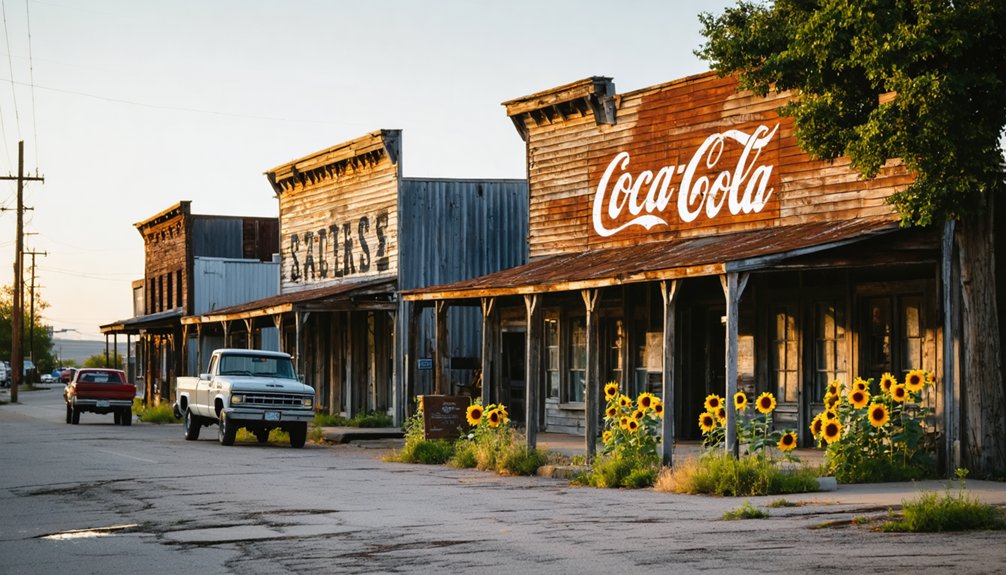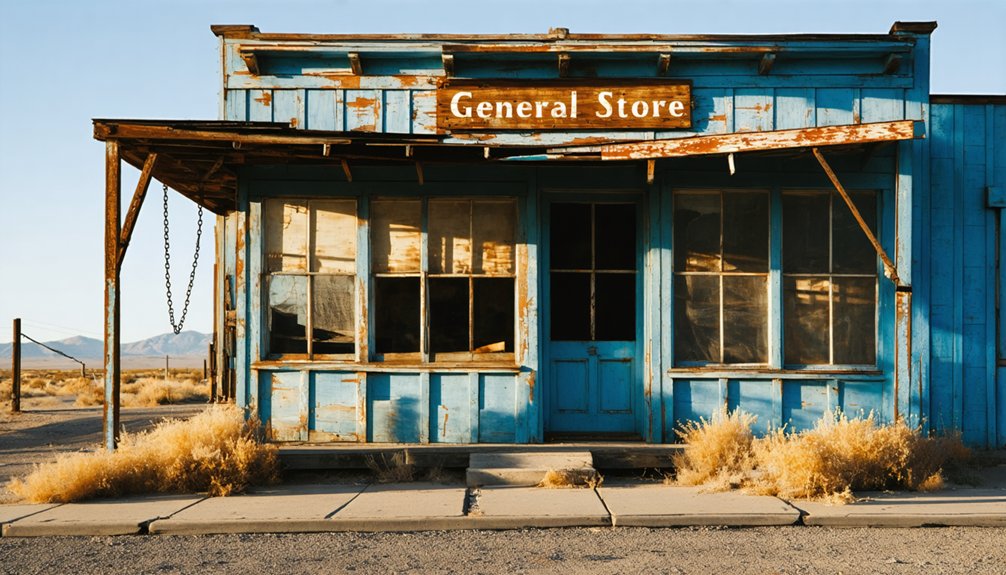You’ll find Guadalupe City located 2 miles north of La Vernia in southwestern Guadalupe County, Texas. This ghost town began as a farming settlement in the late 1820s, with George Lord as its first European settler. The community thrived on cotton cultivation and salt mining, supported by the San Antonio and Mexican Gulf Railway’s arrival in 1860. While the town declined due to economic shifts and population loss, its historic cemetery and church ruins still tell stories of Texas’s frontier past.
Key Takeaways
- Guadalupe City was a 19th-century settlement in southwestern Guadalupe County, located 2 miles north of La Vernia, Texas.
- The town’s economy initially thrived on salt mining, cotton farming, and railway commerce before its eventual decline.
- Population decline began when oil industry relocated, agriculture mechanized, and younger residents migrated to urban areas.
- Historic remnants include the Guadalupe Cemetery, abandoned building foundations, and ruins of Nuestra Señora de Guadalupe Mission.
- The community featured a diverse population of Native Americans, Mexicans, and Anglo-Americans centered around local salt flats.
Origins and Early Settlement
While the Republic of Texas was still in its infancy, George Lord arrived as the first European settler in what would become Guadalupe City. After serving in the Texas volunteer forces and surviving capture during the Mier Expedition, he struck gold in California and returned to purchase 8,000 acres near the future townsite.
The settler challenges attracted resilient families like the Prestons from Georgia and Thomas Baker from Mississippi, who built their homesteads around 1857. Salt mining emerged as an important economic activity, with salt deposits being harvested by both settlers and native inhabitants.
The early community dynamics were unique, featuring a significant population of Genizaros – former Native captives who worked as farm laborers while maintaining certain freedoms. These workers proved essential to the area’s agricultural development.
The establishment of the post office in 1882 marked a pivotal moment in the town’s development, helping transform the rural settlement into a growing commercial center.
Location and Geographic Features
The settlement that Lord and other pioneers established would become Guadalupe City, positioned at 29°22′51″N latitude and 98°05′52″W longitude in southwestern Guadalupe County.
In southwestern Guadalupe County, pioneers carved out Guadalupe City at precise coordinates, marking their claim on Texas soil.
You’ll find this ghost town about 2 miles north of La Vernia and 6 miles south of New Berlin, where geographic isolation eventually led to its decline. The area contains salt deposits that were once highly valued by early settlers and native tribes.
The area’s environmental impact is evident in its characteristic South Texas landscape:
- Rolling plains and wooded areas near the Guadalupe River basin
- Sandy loam soils that once supported traditional farming and grazing
- Mixed prairie vegetation sustained by 28-40 inches of annual rainfall
The humid subtropical climate creates hot summers and mild winters, while seasonal thunderstorms feed local creeks. The area’s foundation consists of ancient concrete structures that date back to early settlement activities, similar to those found in other 19th-century Texas ghost towns.
Farm to Market Road 775 now serves as the primary access point to this former settlement’s location.
Economic Rise and Development
During the late 1820s, Guadalupe City emerged as a farming settlement following Martín De León’s establishment of his colony, with agriculture serving as its economic foundation. The area’s rich, fertile soil made cotton cultivation particularly successful, and by 1930, tenant farming and sharecropping dominated 64% of the county’s agricultural operations. Local records required precise identification to distinguish it from other Guadalupe County locations in the region.
You’ll find that economic sustainability improved considerably with the arrival of the San Antonio and Mexican Gulf Railway in 1860, connecting the city to Victoria and Port Lavaca. Agricultural innovations and changing labor patterns shaped the workforce, which included European settlers, African Americans, and Mexican immigrants. Like many Texas communities that relied on rail transport, Guadalupe City faced economic challenges when automobiles became the preferred mode of transportation.
The establishment of U.S. Highway 87 and a post office further boosted commerce, though the community’s economy remained primarily focused on farming even as neighboring areas diversified into oil production.
Community Life and Social Structure
Since its earliest days, Guadalupe City’s social fabric reflected a diverse mix of Native American, Mexican, and Anglo-American residents whose interactions centered largely around the valuable salt flats.
The community’s informal social networks revolved around resource conflicts, particularly during the El Paso Salt War of the 1860s-1877.
Social bonds in Guadalupe City were forged through struggles over resources, most notably during the bitter El Paso Salt War.
Key aspects of community life included:
- Limited formal institutions, with daily activities focused on salt harvesting and highway commerce
- Ethnic divisions that shaped alliances during disputes over salt deposit control
- Cooperation between Mexican and indigenous communities to defend communal rights
The town lacked permanent structures for education or civic gatherings, reflecting its transient nature.
Fort Bliss’s military presence provided law enforcement during periods of conflict, though the community remained largely self-regulated until its eventual decline.
Like many settlements that became ghost towns in Texas, the community’s population dwindled as economic opportunities shifted elsewhere.
Factors Leading to Decline
Multiple economic, environmental, and demographic forces converged to accelerate Guadalupe City’s decline from a bustling salt-trade outpost to an abandoned settlement.
When the oil industry shifted operations elsewhere, you’d have seen the first major wave of population loss hitting the town’s economic core. Economic downturns in agriculture, coupled with increasing mechanization, eliminated many local jobs that once sustained the community. The severe recurring water scarcity issues, similar to those that plagued Lobo, made agricultural operations increasingly difficult to maintain.
Population dynamics took a severe downturn as younger residents moved to urban areas for better opportunities, leaving behind an aging population and shrinking tax base. The lack of quality housing options made it particularly challenging to retain essential workers, as rental availability was virtually non-existent.
The town’s infrastructure began crumbling as maintenance funds dried up. Natural challenges, including water availability issues and environmental degradation, made it increasingly difficult to sustain local farming operations, further pushing residents to seek opportunities elsewhere.
Historical Landmarks and Remnants
You’ll find the camposanto cemetery on the outskirts of Guadalupe City, marked by simple stone markers and containing numerous infant graves that reflect the harsh realities of frontier life.
The foundations of several key structures remain partially intact, including Senor Cordova’s combination general store and dancehall, along with Antonio’s blacksmith workshop.
The remnants of an early religious site, possibly a Morada used by Los Hermanos Penitentes, suggest the community’s spiritual practices despite lacking a formal church structure or resident priest. Many residents spoke a sixteenth-century Spanish dialect as their primary language, preserving ancient linguistic traditions until the town’s abandonment.
Cemetery and Burial Grounds
The historic Guadalupe Cemetery stands as an essential chronicle of the area’s heritage, with its earliest recorded burial dating to 1913. You’ll find this cemetery’s significance reflected in its diverse collection of gravesites, from civic leaders to military veterans, documenting the community’s evolution throughout the 20th century.
The burial grounds preserve the region’s cultural identity through:
- Military memorials honoring veterans from various conflicts
- Pioneer family plots that showcase early Texas settlement patterns
- Historic markers registered with the Texas Historical Commission
You can explore this well-documented site through the county’s GIS database, which provides detailed location data and historical information.
The cemetery’s traditional Texas rural environment, with its natural landscape and minimal alterations, continues to serve as an essential repository of local genealogical history.
Abandoned Building Foundations
Scattered across Guadalupe City’s abandoned landscape, stone and brick foundations provide essential evidence of the town’s bustling 19th-century past.
You’ll find commercial building remnants along the main thoroughfare, where thick stone walls and worn chisel marks reveal local masonry techniques. Structural analysis shows distinct patterns of saloons, bawdy houses, and gambling establishments that earned the town its wild reputation.
Foundation preservation efforts have uncovered residential footprints perpendicular to the business district, featuring hearths and porch supports typical of period housing.
You’ll spot buried wells and cisterns beneath some foundations, while others reveal charred remains of buildings lost to fire. The ruins paint a clear picture of a grid-pattern settlement, with both permanent masonry structures and temporary wooden buildings marking different phases of the town’s economic development.
Early Church Site Remains
Among the most significant ruins in Guadalupe City stands an early church site connected to 18th-century Catholic missionary efforts near the Rio Grande. Known as Nuestra Señora de Guadalupe Mission, this site served indigenous villages and formed part of a complex mission system in the Texas border region.
You’ll find these notable features in the remains:
- Limestone architectural elements typical of Mission Revival style
- Foundation remnants that suggest a belfry and spire design
- Traces of early stained glass window frames
The site’s religious significance stems from its role as one of the earliest Catholic establishments in the region, where missionary priests like Father Sebastian Augagneur conducted services for scattered settlers.
The Oblate Order managed this territory after the Mexican-American War, continuing the mission’s legacy until its eventual abandonment.
Cultural Heritage and Legacy
While Guadalupe City’s physical structures have largely vanished, its cultural heritage remains deeply woven into the fabric of Texas history through architectural remnants, socioeconomic patterns, and indigenous connections.
You’ll find evidence of cultural resilience in the preserved cemeteries, church ruins, and general store foundations that dot the landscape. The area’s rich heritage preservation efforts highlight the intersection of German-Texan architecture, Anglo-American building traditions, and centuries-old indigenous use of natural resources like salt flats.
The region’s story reflects complex relationships between Native Americans, Mexican settlers, and European immigrants, particularly evident in land disputes and resource conflicts. These cultural layers, combined with the economic shifts from cotton farming to ghost town status, paint a vivid picture of Texas frontier life.
Modern Day Significance

Today, Guadalupe City’s ghost town status belies its significant modern-day impact across multiple domains.
You’ll find its influence extends beyond mere historical curiosity, serving as a valuable resource for ghost town tourism, ecological education, and cultural preservation initiatives. The site’s remote desert location offers unique research opportunities and educational experiences.
Key modern-day functions include:
- Archaeological research site for studying early Texas settlement patterns and border region development
- Living laboratory for environmental scientists examining desert ecosystem adaptation and historical water source sustainability
- Cultural heritage destination where you can explore the intersection of indigenous, colonial, and frontier histories
The town’s weathered remains continue to attract photographers, researchers, and heritage tourists, while providing vital insights into sustainable resource management and human adaptation in harsh environments.
Frequently Asked Questions
Are There Any Paranormal Activities Reported in Guadalupe City?
You won’t find documented evidence of ghost sightings or unexplained noises here. Available research and historical records don’t support any verified paranormal activity claims in this location’s past or present.
What Valuable Artifacts Have Been Discovered in the Ghost Town?
You’ll find significant artifacts including European ceramics, indigenous Rockport pottery, stone tools, and a rare Andice spear point, revealing historical overlap between Native American and Spanish colonial periods.
Can Visitors Legally Explore and Metal Detect in Guadalupe City?
You can’t legally explore or metal detect without explicit landowner permission since it’s private property. Metal detecting regulations require proper authorization, and visitor permissions must be obtained to avoid trespassing violations.
Which Families Were the Last to Leave the Town?
You’ll find the Schlather and Kollasch families were among the last residents, though complete records aren’t definitive. Their family legacy lives on through land deeds and county archives from the late 1800s.
Does Anyone Maintain or Own the Ghost Town Property Today?
You’ll find no clear record of current ownership or regular property maintenance. Public records show uncertain titles, with no single entity documented as maintaining the abandoned structures or land.
References
- https://www.legendsofamerica.com/salt-flat-texas/
- https://theforgottensouth.com/cheapside-texas-ghost-town-history/
- https://jamesbigleyranches.com/general/texas-ghost-towns/
- https://en.wikipedia.org/wiki/Concrete
- https://en.wikipedia.org/wiki/List_of_ghost_towns_in_Texas
- https://texashighways.com/culture/people/my-hometown-a-new-frontier-of-the-old-west-in-dell-city/
- https://www.texasescapes.com/CentralTexasTownsSouth/Guadalupe-City-Texas.htm
- https://www.texasescapes.com/TOWNS/Texas-Ghost-Towns-2-Central-Texas.htm
- https://gr8word.com/index.php/entry/memories-of-guadalupe
- https://en.wikipedia.org/wiki/Seguin



